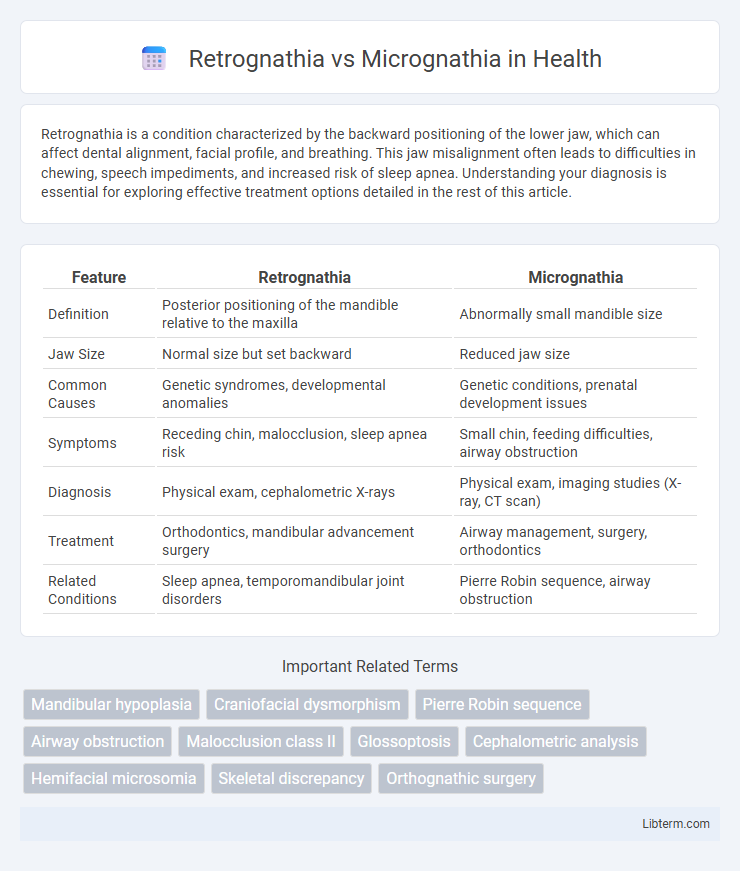Retrognathia is a condition characterized by the backward positioning of the lower jaw, which can affect dental alignment, facial profile, and breathing. This jaw misalignment often leads to difficulties in chewing, speech impediments, and increased risk of sleep apnea. Understanding your diagnosis is essential for exploring effective treatment options detailed in the rest of this article.
Table of Comparison
| Feature | Retrognathia | Micrognathia |
|---|---|---|
| Definition | Posterior positioning of the mandible relative to the maxilla | Abnormally small mandible size |
| Jaw Size | Normal size but set backward | Reduced jaw size |
| Common Causes | Genetic syndromes, developmental anomalies | Genetic conditions, prenatal development issues |
| Symptoms | Receding chin, malocclusion, sleep apnea risk | Small chin, feeding difficulties, airway obstruction |
| Diagnosis | Physical exam, cephalometric X-rays | Physical exam, imaging studies (X-ray, CT scan) |
| Treatment | Orthodontics, mandibular advancement surgery | Airway management, surgery, orthodontics |
| Related Conditions | Sleep apnea, temporomandibular joint disorders | Pierre Robin sequence, airway obstruction |
Introduction to Retrognathia and Micrognathia
Retrognathia is a condition characterized by the posterior positioning of the mandible relative to the maxilla, often resulting in a retruded chin and malocclusion. Micrognathia refers to an abnormally small mandible, which can cause airway obstruction and feeding difficulties, especially in neonates. Both conditions are congenital craniofacial anomalies that affect jaw alignment and facial profile, requiring precise diagnosis for effective treatment planning.
Defining Retrognathia: Key Features
Retrognathia is characterized by the posterior positioning of the mandible relative to the maxilla, resulting in a recessed chin and an imbalanced facial profile. This condition often leads to functional issues such as malocclusion, obstructive sleep apnea, and difficulties with speech or chewing. Unlike micrognathia, which involves an abnormally small jaw size, retrognathia specifically refers to the normal-sized mandible being positioned too far back.
Defining Micrognathia: Essential Characteristics
Micrognathia is characterized by an abnormally small lower jaw (mandible), often leading to difficulties in breathing, feeding, and speech due to restricted oral airway space. This condition is distinct from retrognathia, which involves a normal-sized jaw positioned posteriorly relative to the upper jaw. Key diagnostic features of micrognathia include a receding chin, dental malocclusion, and possible association with syndromes such as Pierre Robin sequence or Treacher Collins syndrome.
Anatomical Differences Between Retrognathia and Micrognathia
Retrognathia is characterized by the posterior positioning of the mandible relative to the maxilla, resulting in a retruded chin and occlusal misalignment, whereas micrognathia involves an underdeveloped or smaller-than-normal mandible size. The key anatomical difference lies in retrognathia's normal mandible size with altered jaw placement, while micrognathia presents a structurally reduced mandible leading to compromised airway space. Imaging studies such as cephalometric analysis effectively distinguish the posterior mandibular displacement of retrognathia from the mandibular hypoplasia observed in micrognathia.
Causes and Risk Factors of Retrognathia
Retrognathia primarily results from genetic mutations affecting jawbone development, including mutations in the FGFR2 and MSX1 genes, which disrupt normal mandibular growth. Risk factors include prenatal exposure to teratogens such as alcohol and tobacco, maternal malnutrition, and certain syndromes like Pierre Robin sequence and Treacher Collins syndrome. Environmental influences combined with inherited conditions significantly increase the likelihood of retrognathia manifestation.
Causes and Risk Factors of Micrognathia
Micrognathia primarily results from genetic disorders such as Pierre Robin sequence, Treacher Collins syndrome, and fetal alcohol syndrome, which affect mandibular development during embryogenesis. Risk factors include maternal smoking, exposure to teratogens, and certain chromosomal anomalies that disrupt normal jaw growth. In contrast, retrognathia is often caused by the posterior positioning of a normally sized mandible rather than an underdeveloped jaw.
Clinical Presentation and Symptoms
Retrognathia presents with a posteriorly positioned mandible, leading to an overbite and facial profile imbalance, often causing difficulties in chewing and speech. Micrognathia is characterized by an abnormally small mandible that can result in airway obstruction, feeding problems, and respiratory distress in severe cases. Both conditions may present with dental malocclusion, but micrognathia commonly triggers early intervention due to functional impairments.
Diagnostic Approaches and Assessment Methods
Retrognathia and micrognathia are diagnosed through detailed clinical examination and advanced imaging techniques such as cephalometric X-rays and 3D CT scans, which help evaluate jaw positioning and bone structure accurately. Assessment methods include measuring mandibular length, analyzing occlusal relationships, and using anthropometric landmarks to differentiate the posterior displacement characteristic of retrognathia from the smaller-than-normal jaw size defining micrognathia. Objective tools like cephalometric analysis software and orthodontic assessments play a crucial role in establishing the severity and planning appropriate treatment strategies for both conditions.
Treatment Options and Management Strategies
Treatment options for retrognathia primarily include orthodontic devices such as mandibular advancement splints and, in severe cases, orthognathic surgery to correct jaw alignment, improving airway function and facial aesthetics. Micrognathia management often involves airway support techniques like continuous positive airway pressure (CPAP) for associated breathing difficulties, with surgical interventions like mandibular distraction osteogenesis reserved for severe deformities to promote jaw growth. Both conditions benefit from multidisciplinary care involving orthodontists, maxillofacial surgeons, and speech therapists to optimize functional outcomes and address feeding or speech challenges.
Prognosis and Long-term Outcomes
Retrognathia, characterized by a retruded mandible, often leads to moderate functional and aesthetic challenges but generally has a better prognosis with early orthodontic or surgical intervention. Micrognathia, involving an abnormally small jaw, presents more severe airway obstruction risks and feeding difficulties, requiring complex multidisciplinary management with often variable long-term outcomes. Both conditions impact facial development, but micrognathia typically demands more intensive treatment and monitoring to optimize growth and functional results.
Retrognathia Infographic

 libterm.com
libterm.com